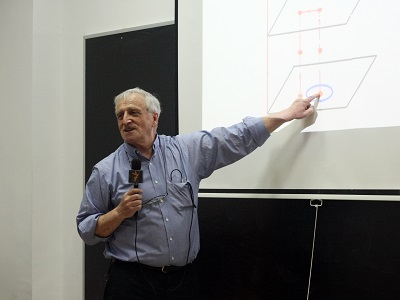On April 21, ISET hosted a public lecture by Tornike Kadeishvili, a resident professor and the head of the Scientific Board of the Andrea Razmadze Mathematical Institute. Professor Kadeishvili spoke about unexpected uses of mathematics in different fields of study, as well as how it can be applied to our everyday lives.
Professor Kadeishvili showed the audience how the human mind works when converting two-dimensional images to 3D, explaining how it is possible to trick the mind with optical illusions and then demonstrating his point using artwork by Morris Escher.
In order to explain the complicated technical details, he provided a simple story of fictional two, three, and four-dimensional worlds and issues that their inhabitants might encounter in their lives.
This story - adapted from the novella Flatland written by Edwin Abbott in 1884 - concerns various worlds inhabited by different geometric figures. Professor Kadeishvili discussed how these creatures would try to explain their worlds to each other, and then invited the audience how a 4-dimensional person would try to explain their world to us. As an example of a hypercube, he showed an image of the Corpus Hypercubus, a surrealist painting depicting Christ's crucifixion on a polyhedron net of a hypercube by Salvador Dali. He went on to discuss how mathematics can explain Hoteling, the rule of equilibrium in Economic theory, and explained why the same kinds of industries usually open and operate in the same area.
In 2015, ISET started a series of public lectures as part of an initiative called “Mathematics Everywhere”. These events are aimed at promoting interest in the subject as a useful tool in different fields of study, such as history, politics, grammar, and especially economics.











